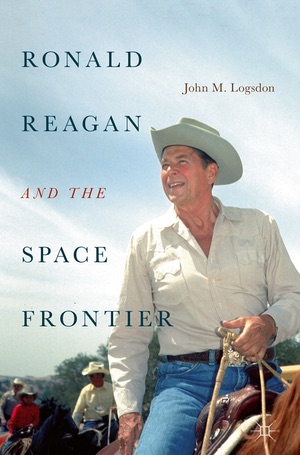Review: Ronald Reagan and the Space Frontierby Jeff Foust
|
| “Reagan was fundamentally an optimist, and space exploration is an optimistic undertaking,” he writes. |
The Reagan Administration’s role in space policy is explored in great detail in John Logsdon’s latest book, Ronald Reagan and the Space Frontier. Just as he did with previous books on the administrations of John F. Kennedy and Richard Nixon (see “Review: John F. Kennedy and the Race to the Moon”, The Space Review, February 28, 2011, and “Review: After Apollo”, The Space Review, March 23, 2015), Logsdon examines the historical record, along with interviews with some administration officials, to study Reagan’s contribution to civil and commercial space policy. He notes in the book’s preface that, of the three books, this was the hardest, as it spanned the longest period of time and with many documents still unavailable.
Reagan came into office without much of a space policy track record, but with a general interest in space exploration that was not surprising to Logsdon. “Reagan was fundamentally an optimist, and space exploration is an optimistic undertaking,” he writes. Reagan showed an interest in the subject—including a fascination with extraterrestrial life, Logsdon notes—but left the details of space policy development to his staff.
The incoming administration’s transition team, led by former NASA deputy administrator George Low, warned of an “unhealthy state of affairs” at the agency caused by a range of issues, including a lack of long-term goals and budgetary problems. Those problems were exacerbated early in the Reagan Administration when David Stockman, the head of the Office of Management and Budget, looked to cut funding from NASA as part of a broader, if ultimately futile, effort to reduce budget deficits. That put into jeopardy NASA’s planetary science program, and with it the Jet Propulsion Laboratory, until a concerted lobbying effort ended the threat.
A key goal for NASA’s new leadership, administrator James Beggs and deputy administrator Hans Mark, was to win approval for a space station program. Much of the policy debate leading up to that decision was handled by a body known as the Senior Interagency Group (Space), or SIG (Space), led by the National Security Council, which handed space policy coordination issues in lieu of the National Space Council of previous and future administrations. It also took over the policy work that had been led, ineffectually, by the Office of Science and Technology Policy in the early days of the administration.
A key figure for SIG (Space) and its debates on the space station and other policy issues was Gil Rye, an Air Force officer detailed to the National Security Council to handle space issues. Rye became a major advocate for the space station within the SIG (Space) debates about whether and how to do a space station, and was credited by people like Mark for his “bureaucratic legerdemain” and advocacy even amid opposition to the station from the Defense Department. “I doubt very much whether space station could have been pushed through the administration” without the efforts of Rye, Mark concluded, even though that advocacy effectively ended his military career.
| “The Reagan space legacy,” Logsdon writes in the book’s final chapter, “is a combination of memorable rhetoric and largely pragmatic practice.” |
The decision to develop the space station is perhaps the biggest civil space policy decision made during the Reagan Administration, and is one key thread in the book. It was not the only major decision, though. NASA and the White House dealt with a number of shuttle-related issues, from pricing of commercial missions early in the program’s history to whether to build a fifth orbiter and, ultimately, the decision after the Challenger accident to end commercial use of the orbiter. There were also numerous commercial space policy issues addressed, from developing a regulatory regime for commercial launches to a failed effort to privatize Landsat, all discussed in detail in the book. (It does not address military space policy issues except where they interact with the civil ones, like use of the shuttle.)
One interesting analysis from the book is the differences between the Reagan Administration’s first and second terms. Many of the key figures from the first term, both at NASA and the White House, were not around for the second term, and their replacements at the agency and SIG (Space) were not as effective. The second term saw few major developments in space policy beyond the decision, triggered by the Challenger accident, to end the commercial use of the shuttle.
So what was the space legacy of Ronald Reagan? The space station shaped NASA’s human spaceflight programs for decades to come, from the Clinton Administration decision in the post-Cold War era to bring the Russians into the project to more recent efforts to turn it into a hub for commercial activity. The Reagan Administration’s advocacy for commercial space may have been premature, from the failure of the Landsat privatization to overhyping markets like space pharmaceuticals that, decades later, have yet to emerge, but it set the foundation for later efforts in launch and commercial remote sensing. Logsdon also cites the development of a “realistic” shuttle policy that swept away the myths of the shuttle providing routine, low-cost access to space, realizing instead it could not be all things to all users, civil, military, or commercial.
“The Reagan space legacy,” Logsdon writes in the book’s final chapter, “is a combination of memorable rhetoric and largely pragmatic practice.” That is, perhaps, not a bad legacy for any administration’s space policy: the memorable rhetoric captures attention, but it’s the pragmatic practice that ultimately delivers the results.
Note: we are temporarily moderating all comments subcommitted to deal with a surge in spam.
